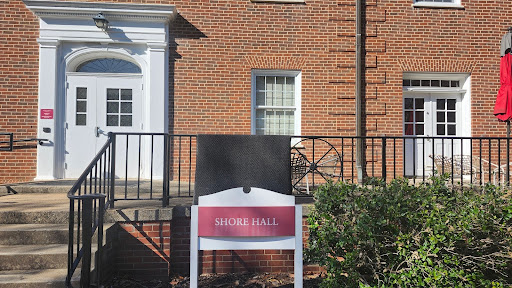Students who have walked to the lake or to the shops in Quaker Village may have noticed houses on campus in addition to the three theme houses. As it turns out, what many believed in elementary school finally came true: many employees who work at Guilford College live here too.
Employee housing on campus can be found between Armfield Athletic Stadium and West Friendly Avenue, on the road that goes through the Guilford woods and even in some of the residence halls.
“(Living on campus) has allowed me to see the life of The college almost on a 24-hour cycle, which is really wonderful because it allows me to, in some ways, sense what the students are going through on campus and to be able to relate to those experiences in a more connected way — as a neighbor, not just as a vice president,” said Vice President for Advancement Ara Serjoie, who began work at Guilford this year.
Currently, employees from many different areas live on campus, including faculty, staff, athletics coaches and admin- istrators in addition to President Jane Fernandes, who lives in the president’s house near Milner Hall.
Because many faculty and administration new to Guilford are also new to Greensboro, they often take the opportunity for on-campus housing early in their time at the College as they settle in. This can cause some issues, as there are a limited number of houses on campus.
College policy dictates that new professors receive priority for moving on campus, a policy of which many residents are not aware. However, this priority becomes more complicated when other variables are added, such as when new employees are hired at various times, including the middle of the school year.
“Generally, housing is assigned on a first come, first served basis,” states section 8.10 of the faculty handbook. “However, other considerations, including size of family, urgency of need for housing and other issues may be taken into consideration.”
In fact, there is a waiting list for on-campus housing, and the College is currently working to meet the need. For one thing, faculty members are required to move after three years.
“We do … have kind of a shortage of houses, so one of the things we’re looking at is how to make more houses available,” said Vice President of Administration and Finance Len Sippel.
While no new houses will be built anytime in the near future, the College is looking at ways to better utilize the spaces already available. For instance, Sippel lives in a house that could comfortably hold more residents, and once he moves out, the house may be converted into two apartments or even a communal living space. Also, the residences not currently owned by the College may eventually become available.
Most of those who live on campus have been hired recently, with the exception of community directors and staff of student life who live on campus to better attend student needs.
Vice President for Academic Affairs Beth Rushing enjoys seeing wildlife, such as the albino deer, currently living in the woods and hearing student parties as a reminder of the lives students have outside of the classroom.
“It’s probably also good for students to know that faculty have lives outside the classroom,” said Rushing. “That we’re three-dimensional human beings who do odd things ourselves.”
Besides enjoying the wildlife and the distant sounds of student parties, many campus residents take walks around campus and attend sporting events. While not every College employee chooses to seek on-campus housing, those who do take advantage of opportunities provided by living close to the Guilford community














